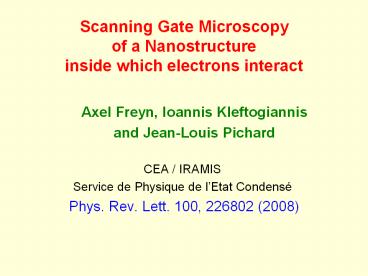Scanning Gate Microscopy of a Nanostructure inside which electrons interact - PowerPoint PPT Presentation
Title:
Scanning Gate Microscopy of a Nanostructure inside which electrons interact
Description:
Part I : The quantum transmission of a nanosystem inside which the electrons ... Part II : Method for probing electron-electron interactions ... AFM cantilever ... – PowerPoint PPT presentation
Number of Views:58
Avg rating:3.0/5.0
Title: Scanning Gate Microscopy of a Nanostructure inside which electrons interact
1
Scanning Gate Microscopy of a Nanostructure
inside which electrons interact
- Axel Freyn, Ioannis Kleftogiannis
- and Jean-Louis Pichard
- CEA / IRAMIS
- Service de Physique de lEtat Condensé
- Phys. Rev. Lett. 100, 226802 (2008)
2
Outline
- Part I The quantum transmission of a
nanosystem inside which the electrons interact
becomes non local. - Part II Method for probing electron-electron
interactions inside a nanostructure using a
scanning gate microscope.
3
The simplest spinless lattice model with a
single nearest neighbor interactionInteracting
nanosystem with six parameters
- 3 Hopping integrals ( td , tc, th 1)
- Nearest neighbor repulsion U n1no
- Gate potential VG
- Filling factor (Fermi energy EF)
4
Interacting nanosystem in series with a one
body scatterer(attached ring pierced by an
Aharonov-Bohm flux) A. Freyn and JLP, Phys.Rev.
Lett. 98, 186401 (2007)
5
Effective nanosystem transmission ts2
(Hartree-Fock approximation)
- Large effect of the AB-flux upon the effective
transmission ts2 - This effect occurs only if the electrons interact
inside the nanosystem
6
The effect of the AB-flux upon the nanosystem
effective transmission falls off with the
distance LC
Decay expected for Friedel oscillations
7
2 nanosystems in seriesY.Asada, A. Freyn and
JLP Eur. Phys. J. B 53, 109 (2006)
8
The results can be simplified at half-filling
(particle-hole symmetry) Hartree corrections
are compensated.
Renormalization of the internal hopping term td
because of exchange
- 1/Lc correction with even-odd oscillations at
half filling.
Friedel Oscillations RKKY interaction
9
Role of the temperature
- The effect disappears when
10
Origin of the non local transmission(Hartree-Fock
theory)
- The external scatterer induces Friedel
oscillations of the electron density inside the
interacting nanosystem - This modifies the Hartree potentials and the
Fock corrections inside the nanosystem. - The nanosystem effective transmission can be
partly controlled by external scatterers when the
electrons interact inside the nanosystem
11
- To neglect electron-electron interactions outside
the nanosystem is not realistic when 1d wires are
attached to it. - This assumption becomes more realistic if one
attaches 2d strips of large enough electron
density
Scanning gate microscopy
12
Scanning gate microscope Topinka,LeRoy,Westervelt
,Shaw,Fleishmann,Heller,Maranowski,GossardLetters
to Nature, 410,183 (2001)
2DEG , QPC AFM cantilever
The charged tip creates a depletion region inside
the 2deg which can be scanned around the
nanostructure (qpc)
- Conductance without the tip
13
Dg falls off with distance r from the QPC,
exhibiting fringes spaced by lF/2
SGM images Conductance of the QPC as a function
of the tip position
g(without tip)2e²/h
14
The electron-electron interactions inside the
QPC can be probed by SGM images
- By lateral gates (or additional top gate), one
reduces the electron density inside the QPC.
This makes the interactions non negligible
inside the QPC, 0.7 (2 e2 /h) anomaly. The
density remains important and the interactions
negligible outside the QPC. - The Friedel oscillations created by the charged
tip can modify the effective QPC transmission, if
the electrons interact inside the QPC
15
A lattice 2d model for SGM
16
HF study of the nanosystemLandauer-Buttiker
conductance of the system (nanosystem tip)
17
Hartree-Fock theory for the interacting
nanosystem coupled to 2d non interacting strips
This self-energy has to be calculated using a
recursive method for different positions of the
tip and energies EltEF
18
Self-consistent solution of coupled integral
equations
19
Conductance of the combined system(nanosystem
tip)
20
Nanosystem conductance without tip(g0lt1)
21
Effect of the tip upon the nanosystem HF
self-energies
22
The effect of the tip upon the Fock self-energy
falls off with rT as the Friedel oscillations
causing it.
23
(Relative) Effect of the tip upon the
conductanceSGM images
24
Without interaction, the effect of the tip upon g
falls off as 1/rT
25
With interaction, there is an additional 1/rT2
decay(U1.7)
26
Strength of the interaction effect upon the SGM
images as a function of the nanosystem parameters
27
Summary
- The effective transmission can be modified by
external scatterers when the electrons interact
inside the nanosystem. - This non local effect can be probed using a
scanning gate microscope (enhanced fringes near
the nanostructure phase shift of the fringes). - In the HF approximation, the effect is induced by
the Friedel (Hartree) or related (exchange)
oscillations created by the external scatterers
inside the nanosystem. - One can make the effect very large by a suitable
choice of the nanosystem parameters. Reducing td
enhances the effect. But an orbital Kondo effect
(yielded by inversion symmetry) occurs when td
goes to 0. - Comparison between HF, DMRG, NRG results
28
References
- R. Molina, D. Weinmann and JLP, Eur. Phys. J. B
48, 243, (2005). - Y. Asada, A. Freyn and JLP, Eur. Phys. J. B 53,
109 (2006). - A. Freyn and JLP, Phys. Rev. Lett. 98, 186401
(2007). - A. Freyn and JLP, Eur. Phys. J. B 58, 279 (2007).
- A. Freyn, I. Kleftogiannis and JLP, Phys. Rev.
Lett. 100, 226802 (2008). - D. Weinmann, R. Jalabert, A. Freyn, G.-L. Ingold
and JLP, arXiv 0803.2780 (2008).
29
(No Transcript)
30
(No Transcript)
31
(No Transcript)
32
(No Transcript)
33
(No Transcript)
34
Equivalent setup (orthogonal transformation)
Role of the internal hopping td
35
Hartree-Fock Equations
1. Original basis
2. Transformed basis
(vAS 0 because of inversion symmetry)































